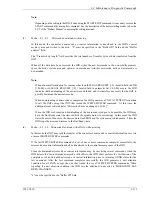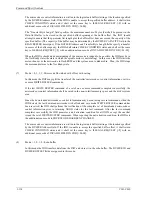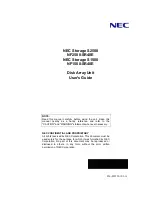
3.4 Maintenance, Diagnostic Commands
C141-C010
3-101
Table 3.6
Error recovery control flags during the self-diagnosis test
PER
DTE
Diagnostic test operation
0
0
The diagnostic test continues when error recovery is successful. The contents of
recovered errors are not reported. When an error which cannot be recovered from is
detected, the diagnostic test terminates at that point with an error.
0
1
– – – – – (Setting prohibited) – – – –
1
0
The diagnostic test continues when error recovery is successful. When an error
which cannot be recovered from is detected, the diagnostic test terminates at that
point with an error. Even when all the detected errors have been recovered, a
CHECK CONDITION status (RECOVERED ERROR [=1]) is reported after the
series of diagnostic tests is completed and the sense data show the contents of the
last error to be successfully recovered from.
1
1
When error recovery is successful, or even when error recovery is impossible, the
diagnostic test is terminated with an error at the point when the permitted error
recovery processing is completed and a CHECK CONDITION status is reported.
The sense data show the contents of the detected error.
Note:
When “1” is specified in the “SelfTest (self test)” bit in this command, the command execution
results are reported by the status and the sense data. Therefore, even if the RECEIVE DIAGNOSTIC
RESULTS command is executed after this command, the self-diagnosis test execution results are not
reported as response data.
Remark:
The error recovery control flag is valid only for PER. Therefore, the only error recovery flag
combination that is actually executed in the above self-diagnosis tests is the (PER, DTE) = (1, 0)
combination.
(2) Parameter
specification
When “0” is specified in the “SelfTest (self test) bit in the CDB, the IDD executes the operations specified in
the parameter list transferred from the INIT by this command. In this case, the IDD reports a GOOD status and
terminates this command at the point when preparation of the “response data” is completed after completing the
specified operations. The INIT can read the execution results (response data) by the RECEIVE DIAGNOSTIC
RESULTS command.
When the “PF (page format)” bit in the CDB is “1,” the parameter list transferred from the INIT by this
command shows the page format, explained later, but the IDD disregards the value specified in this bit
and always handles the page format according to the specifications in the parameter list when the
parameter list is transferred by this command. Also, when the “SelfTest (self test)” bit is “0,” the
specifications in the “DefOfl (device off-line)” bit and the “UnitOfl (unit off-line)” bit have no meaning
and their specified values are disregarded.
The “Parameter list length” field in the CDB shows the length (number of bytes) of the parameter list
that is transferred from the INIT when the “SelfTest (self test)” bit’s specification is “0.” When zero is
specified in the “Parameter list length” field, this command is terminated without anything being
executed. Also, when the value specified in the “Parameter list length” field does not reach the specified
length for the parameter list, explained later, and as a result, not all the bytes in the parameter list can be
Summary of Contents for 80
Page 4: ...This page is intentionally left blank ...
Page 10: ...This page is intentionally left blank ...
Page 18: ...This page is intentionally left blank ...
Page 62: ...This page is intentionally left blank ...
Page 284: ...Sense Data Error Recovery Methods This page is intentionally left blank ...
Page 296: ...This page is intentionally left blank ...
Page 298: ...This page is intentionally left blank ...
Page 308: ...This page is intentionally left blank ...
Page 309: ......
Page 310: ......
















































